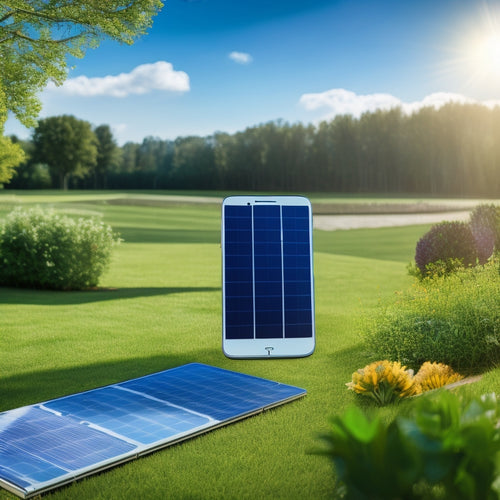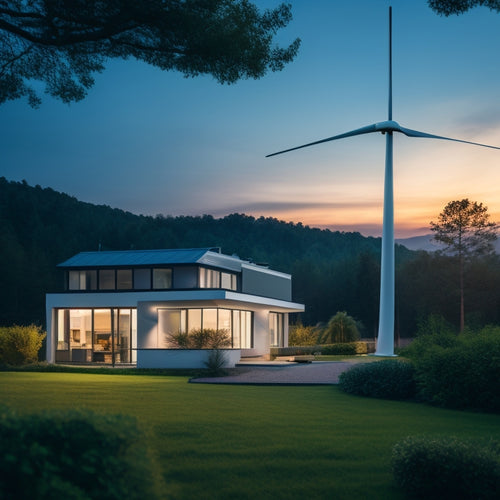
Automate Sunlight: Maximize Energy Savings With Shades
Share
By automating sunlight with smart shades, you can maximize energy savings while maintaining a comfortable and productive environment. Strategic shade positioning reduces your reliance on artificial lighting, capturing sun energy while controlling intensity. Smart shade technology optimizes daylight harvesting, achieving up to 40% energy savings in commercial buildings and 20% in residential buildings. With automated adjustments based on time of day and season, you can enhance energy efficiency and reduce your carbon footprint. Now, uncover how integrating smart shades with your home's systems can reveal even more energy-saving potential and take your sustainable living efforts to the next level.
Key Takeaways
- Automated shade control systems optimize energy savings by up to 40% in commercial buildings and 20% in residential buildings.
- Strategic shade positioning and smart scheduling reduce electric lighting needs, minimizing glare and maximizing natural light distribution.
- Integration with renewable energy sources and real-time monitoring enhance energy efficiency, thermal comfort, and cost savings.
- Smart shades can integrate with popular smart home systems, allowing for voice control and custom automation for maximum convenience.
- Effective thermal management through shading strategies reduces heat gain in summer and maximizes passive heating in winter, further reducing energy consumption.
Harnessing Natural Light Power
By strategically positioning shades, you can employ natural light power to illuminate your space, reducing the need for artificial lighting and maximizing energy savings.
This approach allows you to capture the sun's energy, while also controlling its intensity.
By optimizing light diffusion, you can create a comfortable and productive environment, free from harsh glare.
Effective glare reduction techniques, such as angling shades or using light-filtering materials, can further enhance the benefits of natural light.
Smart Shade Energy Efficiency
You can greatly reduce your energy consumption by leveraging smart shade technology, which offers immense energy savings potential.
Automated shade control systems optimize daylight harvesting, reducing the need for artificial lighting and HVAC usage. By integrating these systems, you'll be able to create a more energy-efficient environment that minimizes energy waste and saves you money.
Furthermore, smart charging systems renewable energy sources can also be integrated with energy storage systems to maintain a stable power supply from excess solar energy, ensuring efficient power supply.
Energy Savings Potential
The smart shade system's energy efficiency capabilities are substantial, with the potential to reduce energy consumption by up to 40% in commercial buildings and 20% in residential spaces. By enhancing daylight and heat, you can enjoy significant cost reduction and improved thermal comfort. Here's a breakdown of the benefits:
| Benefit | Description | Impact |
|---|---|---|
| Light Modulation | Adjusts natural light to balance brightness and glare | 10-15% energy savings |
| Seasonal Adjustments | Automatically adjusts shade position for ideal energy efficiency | 5-10% energy savings |
| Shade Materials | Selects materials that minimize heat gain and maximize reflectivity | 5% energy savings |
Automated Shade Control
Smart buildings rely on automated shade control to optimize energy efficiency. You can maximize your energy savings by automating your shades, allowing you to adjust them according to the time of day, season, and weather.
With shade automation, you can program your shades to open and close at specific times, ensuring that you're getting the most out of natural light while minimizing heat gain. This approach is particularly beneficial for commercial EV charging stations, which can attract eco-conscious consumers and increase foot traffic.
By integrating automated shade control with other energy-efficient systems, such as solar-powered EV charging, you can further reduce your reliance on the grid.
- You can control your shades remotely, adjusting them from anywhere in the building or even from your phone.
- Automated shade control integrates seamlessly with other smart building systems, such as lighting and HVAC.
- You can schedule your shades to adjust automatically, ensuring that you're saving energy even when you're not thinking about it.
- Automated shade control can be integrated with sensors to detect changes in natural light and adjust accordingly.
- With automated shade control, you can create customized scenes for different times of day or activities, giving you ultimate control over your building's energy efficiency.
Optimized Daylight Harvesting
Automated shade control sets the stage for optimized daylight harvesting, where the focus shifts from simply adjusting shades to maximizing the energy-saving potential of natural light.
By utilizing natural daylight, you can reduce your reliance on artificial lighting and greatly lower energy costs. Additionally, integrating solar-powered charging solutions can further reduce your carbon footprint and energy costs solar-powered EV charging.
Optimized daylight harvesting involves strategically positioning and adjusting shades to distribute natural light evenly throughout your space. This daylight optimization technique guarantees that you're getting the most out of the sun's natural energy, reducing the need for artificial lighting and resulting in substantial energy savings.
Automated Sunlight Control Systems
Controlling sunlight with precision, you can release significant energy savings by utilizing the power of automated sunlight control systems. By integrating automated shading, light sensors, and energy management, you can enhance your building's energy efficiency.
These systems learn your user preferences and adjust accordingly, ensuring a comfortable and productive environment. Automated shading systems can also complement renewable energy solutions to further reduce reliance on fossil fuels and carbon footprint. Additionally, they can be designed to work in tandem with solar panels, allowing for supplementary power and extended vehicle range.
-
Automated shading systems adapt to changing climate conditions, ensuring maximum energy savings.
-
Remote control capabilities allow for seamless adjustments to your lighting needs.
-
Design aesthetics are preserved with sleek, modern installations that blend into your building's design.
-
Cost implications are minimized with reduced energy consumption and extended equipment lifespan.
-
Stay ahead of technology trends with scalable, future-proof systems that integrate with existing infrastructure.
Optimizing Daylight Harvesting Benefits
You can optimize daylight harvesting benefits by controlling natural light to reduce the need for artificial lighting.
Regular maintenance, including cleaning and inspecting connections, is crucial for optimizing performance and guaranteeing longevity, as regular cleaning of solar panels can prevent up to 20% efficiency loss.
By doing so, you'll enhance energy efficiency and create a more comfortable work environment.
Smart shade scheduling guarantees that your shades are adjusted to maximize natural light when it's available, minimizing the need for electric lighting.
Natural Light Control
In tandem with reducing heating and cooling loads, optimizing daylight harvesting benefits requires a thoughtful approach to natural light control.
You need to take into account how to effectively manage natural light to reduce the need for artificial lighting, which can greatly impact your energy consumption.
-
Use light-diffusing materials to scatter natural light, reducing harsh glare and hotspots.
-
Install shades with varying opacity to control the amount of natural light entering your space.
-
Take into account the orientation of your windows and adjust your shading strategy accordingly.
-
Implement a scheduling system to automate shade adjustments based on the time of day and season.
-
Integrate your shading system with other building management systems to optimize energy efficiency.
Energy Efficiency Boost
By optimizing daylight harvesting benefits, your building can experience a significant energy efficiency increase.
You can achieve this by selecting the right shade materials that balance daylight exposure with thermal comfort. Consider window orientation, insulation effectiveness, and user preferences for color temperature to minimize energy consumption.
Seasonal adjustments to your shading system will further reduce your environmental impact. A well-designed system not only enhances productivity but also adds aesthetic value to your building.
Smart Shade Scheduling
Most commercial buildings can realize up to 40% energy savings by implementing smart shade scheduling. By optimizing daylight harvesting benefits, you can reduce the need for artificial lighting and minimize energy waste. This is achieved through advanced scheduling algorithms that adjust shade positions based on factors like time of day, season, and weather.
-
Stay ahead of shade technology trends with automated shade control systems that learn and adapt to your building's unique conditions.
-
Utilize data analytics to fine-tune your scheduling strategy and maximize energy savings.
-
Integrate with building management systems (BMS) to optimize overall building performance.
-
Schedule shades to optimize natural light and reduce glare.
-
Use real-time monitoring to identify opportunities for improvement and adjust your strategy accordingly.
Reducing Heat Gain in Summer
During summer's peak, three-quarters of the sun's energy that enters through your windows is converted into heat, making your air conditioner work overtime. To reduce heat gain, you need to control sunlight exposure. Effective shade materials can block up to 90% of the sun's heat, improving thermal comfort and energy performance. Consider climate adaptation when selecting shades, as they should be designed to suit your region's climate.
| Window Orientation | Shade Type | Heat Reflection |
|---|---|---|
| East/West | Overhangs | 60-80% |
| South | Awnings | 70-90% |
| North | Solar Screens | 40-60% |
| Skylights | Solar Tubes | 50-70% |
Maximizing Passive Heating Winter
As you shift your focus from reducing heat gain in summer to maximizing passive heating in winter, you'll want to optimize your shading strategy to capture the sun's natural warmth.
By doing so, you'll improve thermal comfort and reduce your reliance on artificial heating.
-
Open your shades during the day to let winter sunlight in, warming your space naturally.
-
Close them at night to retain the heat and prevent it from escaping.
-
Consider using thermal shades that can help insulate your windows.
-
Adjust your shading strategy based on the time of day and outdoor temperature.
-
Use sensors and automation to optimize your shading system for maximum energy savings.
Seamless Integration With Smart Homes
How seamlessly do your shades integrate with your smart home system? With seamless automation, you can experience the ultimate in convenience and energy efficiency. Imagine adjusting your shades with a single voice command or automating them to optimize natural light and heat.
| Smart Home System | Integration Method | Benefits |
|---|---|---|
| Amazon Alexa | Voice Control | Hands-free control |
| Google Home | Voice Control | Hands-free control |
| Apple HomeKit | App Control | Remote access |
| Samsung SmartThings | API Integration | Custom automation |
| IFTTT (If This Then That) | Conditional Automation | Custom scenarios |
Energy Monitoring and Insights
You've fine-tuned your shades for seamless smart home integration, now it's time to take energy efficiency to the next level.
Energy monitoring and information are vital to maximizing your cost savings. With real-time data analytics, you can track your energy consumption and identify usage patterns that impact your power monitoring. This information enables you to make informed decisions to reduce your energy usage and enhance your shade automation.
- Track your energy consumption in real-time to identify areas for improvement
- Analyze usage patterns to understand how your daily habits impact your power monitoring
- Set performance tracking goals to guarantee you're meeting your efficiency benchmarks
- Gain behavioral knowledge to adjust your habits and maximize cost savings
- Monitor your progress and make adjustments to maintain peak energy efficiency
Boosting Sustainability at Home
By integrating smart shades into your daily routine, you're not only reducing energy consumption but also taking a significant step towards a more sustainable lifestyle.
You're embracing eco-friendly materials, energy-efficient technologies, and sustainable design principles. This marks a significant shift towards green building practices, utilizing passive solar power, and capitalizing on renewable resources.
Furthermore, smart shades complement home insulation, energy audits, and carbon footprint reduction efforts. By automating sunlight, you're minimizing your environmental impact, contributing to a cleaner, healthier planet.
With smart shades, you're in control, making conscious choices that align with your values and promote a sustainable future.
Frequently Asked Questions
How Do I Ensure My Automated Shades Are Compatible With My Existing Windows?
As you upgrade to automated shades, coincidentally, you're ensuring energy efficiency. To guarantee compatibility, measure your windows accurately and research compatible shade types, considering factors like recessed or surface-mounted installations, to seamlessly integrate with your existing windows.
Can I Control My Shades Remotely Using a Smartphone App?
You can control your shades remotely using a smartphone app, leveraging remote functionality and seamless smartphone integration, allowing you to adjust lighting and ambiance from anywhere, at any time, granting you ultimate freedom and convenience.
Are There Any Specific Shade Materials That Provide Better Energy Efficiency?
You'll find that certain shade materials enhance energy efficiency; look for ones with high insulation properties, like cellular shades or thermal shades, which can reduce heat gain by up to 80%, letting you save big on energy bills.
Will Automated Shades Interfere With My Home's Interior Design Aesthetic?
Imagine a canvas, where your home's design is the art. Automated shades won't ruin the masterpiece; they'll blend seamlessly, offering design integration and aesthetic versatility, ensuring your space remains a reflection of you, while still reaping energy-saving benefits.
How Often Should I Clean and Maintain My Automated Shades for Optimal Performance?
You'll want to clean your automated shades every 2-3 months, depending on usage, to guarantee peak performance; for maintenance, simply dust with a soft cloth and avoid harsh chemicals to keep your shades running smoothly and efficiently.
Related Posts
-

7 Best Solar Panel Upkeep Apps for Homeowners
You can optimize your solar panel's energy output and efficiency by up to 20% with regular maintenance, which is wher...
-

10 Grid-Tied Wind Power Systems for Modern Homes
You're looking for a grid-tied wind power system to utilize wind energy for your modern home. Here are ten options to...
-

10 Powerful Electric Mowers for Expansive Lawns
You're moving away from gas-powered mowers and exploring electric options for your expansive lawn. You'll find that h...


